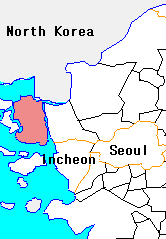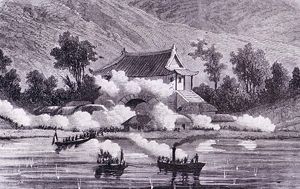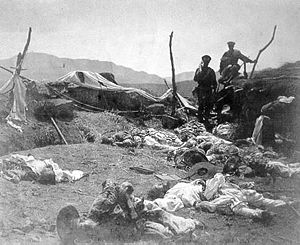Ganghwa Island
| Ganghwa Island | ||||||||
|---|---|---|---|---|---|---|---|---|
 | ||||||||
| Korean name | ||||||||
|
Ganghwa Island (江華島) is an island in the estuary of the Han River, on the west coast of South Korea. About 65,500 people live on the island. With an area of 302.4 km², it constitutes most of Ganghwa-gun, a division of Incheon Municipality. The island's highest point is Mani-san, 469 meters above sea level. It is the 5th largest island in South Korea.
Location
Ganghwa Island is separated from Gimpo, on the mainland, by a narrow channel, which is spanned by several bridges. The main channel of the Han River separates the island from Gaeseong in North Korea.
Mythology
The legendary god-king Dangun is said to have made an altar on top of Mani-san and offered sacrifices to his ancestors.[1]
Early History
Because of its strategic position in the mouth of the Han River, Ganghwa Island has often played a key role in historical events. In the ninth century, Unified Silla established a garrison on the island to combat piracy.[2] The commander Wang Geon established his military reputation at the garrison, later going on to found the kingdom of Goryeo.[3] In the thirteenth century, the court of Goryeo took refuge on the island as Mongol forces invaded in 1232.[4] After Goryeo capitulated to the Mongols, the elite forces on the island rose up, beginning the Sambyeolcho Rebellion.[5] During the Manchu invasion of 1636, the Joseon court sought to follow the Goryeo example, but the royal refugees were captured by the invaders.[6]
Encounters with Foreign Influences
French Invasion
In the nineteenth century, as outside powers sought to enter Korea by sea, Ganghwa became a point of contact rather than a refuge. In the early 19th century, Christianity (Catholicism) was introduced into Korea despite its official proscription by the Korean court. In 1866, reacting to greater numbers of Korean converts as well as the humiliations suffered by China at the hands of Westerners during the Opium Wars, the Korean court clamped down on the illicit French missionaries, massacring French Catholic missionaries and Koreans converts alike. That same year France launched a punitive expedition against Korea, invading and occupying portions of Ganghwa Island in the fall of 1866.
At the first battle, the Korean infantry division lost heavily, and General Yang Haun-Soo concluded that only a large cavalry division could stand up to French firepower. An ambush by Korean forces on a French party attempting to occupy the strategically located Cheondeung Temple 傳燈寺 on the island‘s south coast resulted in French casualties. French realization that they were far outnumbered and outgunned forced them to abandon the island and their expedition. The entire incident later became known as the byeong-in yang-yo, or foreign disturbance of the byeong-in year (1866).
US Asiatic Squadron
The US Asiatic Squadron visited the island in May 1871, with the primary excuse as the USS General Sherman incident in Pyongyang, although the main objective of the expedition was to establish trade and diplomatic relations with Korea. In case of USS General Sherman in 1866, Americans killed the Korean inhabitants, plundered the coastal area, and kidnapped a military officer. For this, the angered Korean population burnt down the ship. Misunderstanding between the both sides brought them into conflict. General Rodgers was the leader of the fleet, and was trying to find a direct waterway route to the Korean capital Hanyang (present-day Seoul). He happened to find the island, and made contacts with the Koreans. At the first meeting, the Americans warned the Koreans that the fleet would be investigating the area, and, therefore, not to worry. But, when the fleet passed the Korean territorial boundary, the fortress opened fire. For this aggression, General Rodgers requested for a negotiation, to which the Koreans replied, “We have been living 4,000 years without any treaty with you, and we can't see why we shouldn't continue to live as we do.” The fact that the Korean cannons could not aim properly due to some errors in the setup caused the bullets to go past the ships, and allowed the American fleet to bombard the fortresses and take them over with the infantry.

In 1875 a Japanese ship, Unyo, explored into the restricted areas in name of measuring the coastline, and fired a few shots at the fortress on the island. When a crew boat was sent to the island, Koreans fired a few shots back (Ganghwa Island incident). The Japanese argued that this was an aggression and demanded a treaty. Early in the following year, Japan sent a large force of the Imperial Japanese Navy, and the Treaty of Ganghwa was concluded. That agreement, concluded on Ganghwa Island, officially opened Korea to Japanese trade for the first time during the 19th century (although trade did go on before Japan westernized and Korea became a hermit kingdom).
Notes
- ^ Lee (1976, p. 96).
- ^ Lee (1976, p. 100).
- ^ Lee (1976, p. 148).
- ^ Lee (1976, p. 151).
- ^ Lee (1976, p. 216).
- ^ Lee (1976, p. 264); Nahm (1996, p. 148).
- ^ Lee (1976, p. 268); Nahm (1996, p. 151).
ReferencesISBN links support NWE through referral fees
- Nahm, Andrew C. (1996). Korea: A History of the Korean People, 2nd ed., Seoul: Hollym. ISBN 1-56591-070-2.
- Lee, Ki-baek (1976). A New History of Korea, rev. ed., Seoul: Ilchogak. ISBN 89-337-0204-0.
See also
- List of Korea-related topics
- Seoul National Capital Area
- Geography of South Korea
- Islands of South Korea
- Ganghwa Island affair
Credits
New World Encyclopedia writers and editors rewrote and completed the Wikipedia article in accordance with New World Encyclopedia standards. This article abides by terms of the Creative Commons CC-by-sa 3.0 License (CC-by-sa), which may be used and disseminated with proper attribution. Credit is due under the terms of this license that can reference both the New World Encyclopedia contributors and the selfless volunteer contributors of the Wikimedia Foundation. To cite this article click here for a list of acceptable citing formats.The history of earlier contributions by wikipedians is accessible to researchers here:
The history of this article since it was imported to New World Encyclopedia:
Note: Some restrictions may apply to use of individual images which are separately licensed.



